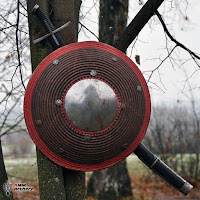 Round shields are common in many cultures, but the striking features of kalkan are: light but very durable construction from spirally bound twigs “sewn” by thread and rather complex system of grips and loops, that can be used by a skilled warrior to protect himself from the front, sides, or back, as necessary, at the same time shooting his bow or fencing with spear or saber. This flexible technique was ideally suited for the light cavalry tactics of alternate attacks and retreats (and, to the modern spectators, immediately connotes with “ninja turtles” cartoon).
Round shields are common in many cultures, but the striking features of kalkan are: light but very durable construction from spirally bound twigs “sewn” by thread and rather complex system of grips and loops, that can be used by a skilled warrior to protect himself from the front, sides, or back, as necessary, at the same time shooting his bow or fencing with spear or saber. This flexible technique was ideally suited for the light cavalry tactics of alternate attacks and retreats (and, to the modern spectators, immediately connotes with “ninja turtles” cartoon).In this article I would like to present results of my experiments in reconstruction of methods to hold, carry and hang shield on the horse. As far as I know, this is a first successful attempt to recreate a way of using kalkan.